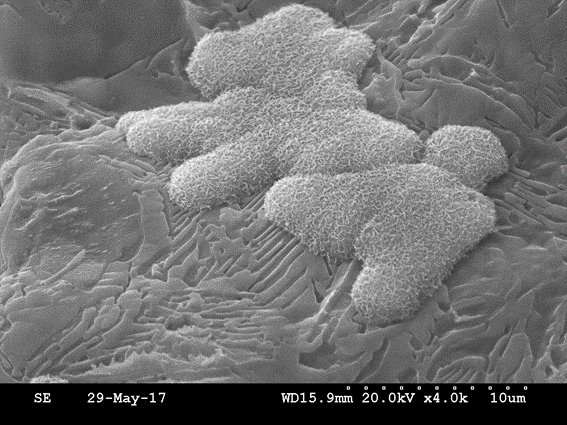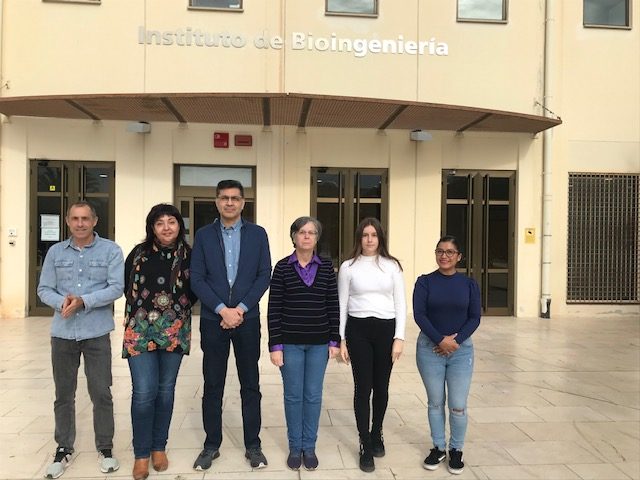Biomaterials
| Responsible | Piedad N de Aza Moya |
RESEARCH SUMMARY
Biomaterials are widely used today in all clinical specialties and include all classes and subclasses of materials. They have an important place in the modern economy and in society due to a growing demand. The main reason for this is the increase in life expectancy and the morbidity of injuries caused by traffic accidents, sports and armed conflicts. These traumas, in general, seriously damage living organs that must be totally or partially replaced with materials that maintain their functional or structural properties.
Despite the large number of developments in the field of biomaterial science and technology in recent years, there is currently no biomaterial capable of fully reproducing the characteristics and functions of the original organ or tissue that it replaces.
The purpose of this group have a great social impact such as improving the health and quality of life of the population through the design and obtaining of new biomaterials.
RESEARCH LINES
PHASE EQUILIBRIUM DIAGRAMS IN OXIDE SYSTEMS
Research activities are mainly based on the theoretical and experimental study of phase equilibrium diagrams. We are dedicated to increasing the basic knowledge of thermodynamics, synthesis, processing, properties and service performance of ceramic materials. Work in the field of bioceramics for bone engineering and guided bone regeneration, which applied the knowledge in phase equilibrium diagrams, were stared in 1995. The research group accumulates more than 20 years of experience in the use of phase transformation techniques based on differential thermal analysis, X-ray diffraction, for studies of solid state reactions and transformation mechanisms.

Silicocarnotite-phase A subsystem and material with eutectoid microstructure.
DEVELOPMENT OF 3D OPTIMIZED SCAFFOLDS
We develop new materials capable of solving various bone problems. 3D structures with interconnected porosity meet general requirements such as allowing cell migration, diffusion of debris and nutrients. Furthermore, depending on the chemical composition of the 3D structure, it is possible to obtain excellent in vitro bioactivity and in vivo biocompatibility.
Our group, based on the knowledge acquired in the development of dense materials, began with the development of monocompositional materials, trying to unify mechanical resistance with bioactivity. Thus we develop 3D ceramics with different microstructures using the polymeric replica technique. We also obtain multicompositional 3D structures, composed of a core, made up of a composition that provides mechanical resistance to the material (between 0.9 – 1.8MPa), which in turn is covered by various layers of composition other than the heart, responsible for modulating the bioactivity of the material. The external layers can have the same composition or change the composition from layer to layer, with which a material with different compositions can be obtained, where the first gives the 3D structure mechanical properties and the upper layers modulate the bioactivity, depending on the requirements of the patient, whether male or female.

Schematic representation of a 3D multilayer scaffold and 3D ceramic material
BONE TISSUE ENGINEERING
One of the challenges of the 21st century in biomedicine is to achieve materials capable of stimulating the regeneration and repair of damaged bone tissues. In bone tissue engineering, a new generation of multifunctional materials is needed that temporarily act to support and stimulate the adhesion, differentiation and colonization of osteoprogenitor cells and that promote vascularization. These materials must be capable of acting as carriers of osteoinductive factors and that promote angiogenesis and / or drugs with a therapeutic action, at the same time that they dose their release to the biological environment. New scaffolds must have an initial mechanical strength similar to that of the tissue they replace, and degrade at the implantation site at a rate similar to that at which the new tissue grows.
With this objective in mind, we proceed to design, process, prepare, characterize and study in vitro and in vivo custom materials, in the form of granules, cements or scaffolds, with high interconnected macroporosity, which allow the adjustment of the bioresorbability and release rate of trace elements and / or active principles, all in order to modulate their osteoinductive and / or angiogenic capacity.

Comparison between a 3D ceramic material and a natural cancellous bone
.
<!–
| Responsible | Piedad N de Aza Moya |
RESEARCH SUMMARY
Biomaterials are widely used today in all clinical specialties and include all classes and subclasses of materials. They have an important place in the modern economy and in society due to a growing demand. The main reason for this is the increase in life expectancy and the morbidity of injuries caused by traffic accidents, sports and armed conflicts. These traumas, in general, seriously damage living organs that must be totally or partially replaced with materials that maintain their functional or structural properties.
Despite the large number of developments in the field of biomaterial science and technology in recent years, there is currently no biomaterial capable of fully reproducing the characteristics and functions of the original organ or tissue that it replaces. The purpose of this group has a great social impact such as improving the health and quality of life of the population through the design and obtention of new biomaterials.
RESEARCH LINES
Line1: Biomaterials phase equilibrium diagrams in oxide systems
Research activities are mainly based on the theoretical and experimental study of phase equilibrium diagrams. We are dedicated to increasing the basic knowledge of thermodynamics, synthesis, processing, properties and service performance of ceramic materials. Work in the field of bioceramics for bone engineering and guided bone regeneration, which applied the knowledge in phase equilibrium diagrams, were stared in 1995. The research group accumulates more than 20 years of experience in the use of phase transformation techniques based on differential thermal analysis, X-ray diffraction, for studies of solid state reactions and transformation mechanisms.

Silicocarnotite-phase A subsystem and material with eutectoid microstructure.
Line2: Development of 3D optimized scaffolds
We develop new materials capable of solving various bone problems. 3D structures with interconnected porosity meet general requirements such as allowing cell migration, diffusion of debris and nutrients. Furthermore, depending on the chemical composition of the 3D structure, it is possible to obtain excellent in vitro bioactivity and in vivo biocompatibility.
Our group, based on the knowledge acquired in the development of dense materials, began with the development of monocompositional materials, trying to unify mechanical resistance with bioactivity. Thus we develop 3D ceramics with different microstructures using the polymeric replica technique. We also obtain multicompositional 3D structures, composed of a core, made up of a composition that provides mechanical resistance to the material (between 0.9 – 1.8MPa), which in turn is covered by various layers of composition other than the heart, responsible for modulating the bioactivity of the material. The external layers can have the same composition or change the composition from layer to layer, with which a material with different compositions can be obtained, where the first gives the 3D structure mechanical properties and the upper layers modulate the bioactivity, depending on the requirements of the patient, whether male or female.
Schematic representation of a 3D multilayer scaffold and 3D ceramic material
Line3: Bone tissue engineering
One of the challenges of the 21st century in biomedicine is to achieve materials capable of stimulating the regeneration and repair of damaged bone tissues. In bone tissue engineering, a new generation of multifunctional materials is needed that temporarily act to support and stimulate the adhesion, differentiation and colonization of osteoprogenitor cells and that promote vascularization. These materials must be capable of acting as carriers of osteoinductive factors and that promote angiogenesis and / or drugs with a therapeutic action, at the same time that they dose their release to the biological environment. New scaffolds must have an initial mechanical strength similar to that of the tissue they replace, and degrade at the implantation site at a rate similar to that at which the new tissue grows.
With this objective in mind, we proceed to design, process, prepare, characterize and study in vitro and in vivo custom materials, in the form of granules, cements or scaffolds, with high interconnected macroporosity, which allow the adjustment of the bioresorbability and release rate of trace elements and / or active principles, all in order to modulate their osteoinductive and / or angiogenic capacity.
Comparison between a 3D ceramic material and a natural cancellous bone
.
–>

P. Ros-Tárraga, C.M. Martínez, M.A. Rodríguez, P.N. De Aza
3D calcium silicophosphate porous scaffold: in vitro and in vivo response
Ceramics International (2023).
E. Sebastián, A. Murciano, P.N De Aza, P. Velasquez
Synthesis of 3D porous ceramic scaffolds obtained by the sol-gel method with surface morphology modified by hollow spheres for bone tissue engineering applications
Ceramics International (2023).
N.A. Mata, M. Arango-Ospina, P. Velasquez, A. Murciano, P.N. De Aza, A.R. Boccaccini
Effect of Sr, Mg and Fe substitution on the physico-chemical and biological properties of Si-Ca-P multilayer scaffolds
Boletín de la Sociedad Española de Cerámica y Vidrio (2023).
A. Gehrke, J. Aramburú Júnior, T.L. Eirles Treichel, T.Dias do Prado, B.A. Dedavid, P.N. de Aza.
Effects of insertion torque values on the marginal bone loss of dental implants installed in sheep mandibles
Scientific Reports 12, 538 (2022).
A. Mata, P. Ros- Tárraga; P.Velásquez; Á. Murciano; P. N De Aza
3D multiphasic and multilayer porous scaffolds of calcium phosphates doping with silicon and magnesium
Boletín de la Sociedad Española de Cerámica y Vidrio 61, 384-396 (2022).
E. Sebastián, A.Murciano, R. Madrigal, P.N De Aza, P. Velasquez
3D CaP porous scaffolds with grooved surface topography obtained by the sol-gel method
Ceramics International 47: 21466-21475 (2021).
N.A. Mata, P. Velasquez, A. Murciano, P.N. De Aza
Multilayer Mg-pyrophosphate glass ceramic with discontinuous bioactivity. Physicochemical characterization.
Ceramics International 47(10), 14612-14620 (2021).
N.A. Mata, P. Ros-Tárraga, P. Velasquez, A. Murciano, P.N. De Aza
Synthesis and Characterization of 3D multilayer porous Si-Ca-P scaffolds doped with Sr ions to modulate in vitro bioactivity
Ceramics International. 46 (1) 968–977 (2020).
A. Díaz-Arca, P. Ros-Tárraga, P. Velasquez, P. Mazón, P.N. de Aza
Mechanism of in vitro reaction of a new scaffold ceramic similar to a porous bone
Journal of the European Ceramic Society 40 (5), 2200-2206 (2020).
P. Ros-Tárraga, P. Mazón, B. Revilla-Nuin, R. Rabadán-Ros, P.N. de Aza, L. Meseguer-Olmo
High temperature CaSiO3-Ca3(PO4)2 ceramic promotes osteogenic differentiation in adult human mesenchymal stem cells
Materials Science & Engineering C – 107 110355 (2020).
Osteoinductive biomaterials in the treatment of necrotic lesions derived from radiotherapy, chemotherapy and drugs (CIAICO/2021/157). Funding agency: Conselleria de Innovación, Ciencia y Sociedad Digital, GVA. AICO Program for Consolidated Groups of the Valencian Community. Duration: 2022-2024
PI1: Piedad N. De Aza Moya PI2: Ángel Murciano Cases
__________________________________________________________________________________________________________________________________
Scaffolds with surface morphology enhancers of cell growth and differentiation (PID2020-116693RB-C21). Funding agency: Ministry of Science and Innovation MCIN/AEI/ 10.13039/501100011033. Duration: 2021-2024
PI: Piedad N. De Aza Moya
Footwear in the 21st century: New skills for the design of drastically improved comfort, sustainable, fashion-oriented and scientifically-led footwear products” (SciLED). Funding agency: European Union- .601137-EPP-1-2018-1-RO-EPPKA2-KA. Duration: 01/01/2019 – 31/12/2021.
PI: Miguel Ángel De la Casa Lillo
Synthesis, characterization and biocompatibility of ceramic scaffolds made with third generation materials. Grant from the Santiago Grisolía program for the hiring of research staff in predoctoral training. Funding agency: Conselleria de Educación, Investigación, Cultura y Deportes. Duration: 2018-2021.
PI: Piedad N. de Aza Moya
Multifunctional ceramic biomateriales with hierarchized structures for bone regeneration and/or controlled release of biological agents. Funding agency: Ministry of Economy and Competitivity. Duration: 2014-2017.
PI: Piedad N. de Aza Moya
PhD Dissertations
Nayarit A. Mata Alayon (2022). Synthesis and characterization of multilayer 3D porous ceramic structures obtained through the sol-gel process for application in bone tissue engineering.
Anabel Diaz Arca (2021). 3D tricalcium phosphate-silicocarnotite scaffolds with micro-/nano-eutectoid structure and in situ formation of apatite.
